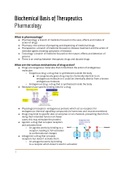Summary
Pharmacology basics summary
- Course
- Institution
Covers: drug action, ADME processes, clinical drug discovery, concentration-response curve, in vivo/in vitro/ex vivo measurements, Emax, drug potency, cell receptors, types of drugs, Schild plot and a bit more
[Show more]



